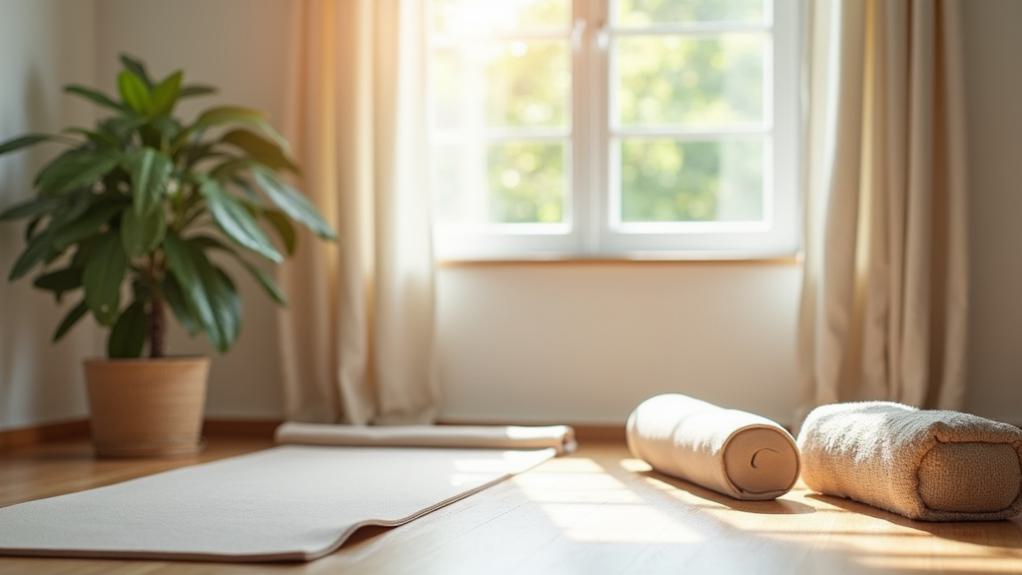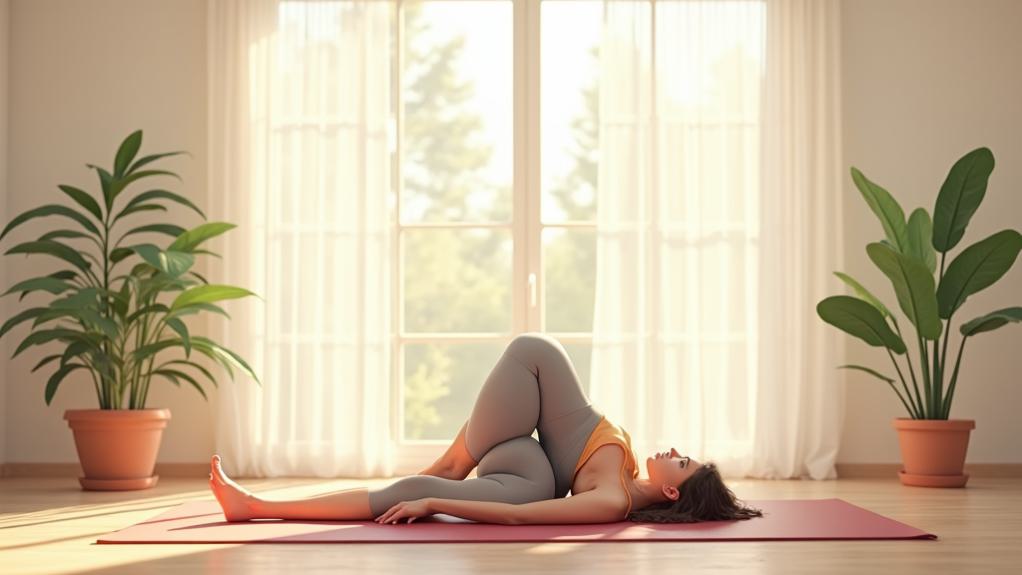Simple stretches can greatly relieve tension after a long day. Try seated spinal twists and shoulder shrugs to ease tightness in your upper body. Incorporating neck rolls and gentle head tilts can alleviate discomfort in your neck.
Grounding poses like Child’s Pose help relax your lower back and promote deep breathing. For hip relief, consider the Pigeon Pose or Reclined Figure-Four Stretch after prolonged sitting. Engage in these stretches for 5 to 10 minutes to enhance your well-being.
By exploring additional techniques, you can integrate a more effective stretching routine for ongoing relief.
Key Takeaways
- Perform gentle neck rolls and shoulder shrugs to release tension in the neck and shoulders after a long day.
- Incorporate seated spinal twists to enhance spinal mobility and alleviate discomfort from prolonged sitting.
- Use Child’s Pose to relax the lower back and promote deep breathing for overall stress relief.
- Try the Double Knee to Chest Stretch to target the lower back and provide immediate relief.
- Dedicate 5 to 10 minutes for end-of-day stretching to effectively release daily tension and improve relaxation.
Benefits of Stretching
Stretching is an important practice for anyone looking to enhance their physical well-being. By incorporating stretching into your routine, you can greatly improve flexibility and increase your range of motion, which is essential for maintaining overall fitness and preventing injuries.
Regular stretching helps reduce muscle tension and soreness, providing much-needed relief after long periods of sitting or engaging in physical exertion.
Moreover, stretching promotes relaxation and stress relief, contributing positively to your mental well-being. It enhances blood circulation to your muscles, facilitating better oxygen flow and overall muscle health. This improved blood flow can help alleviate discomfort and reduce the risk of injuries associated with tight muscles.
Additionally, a consistent stretching routine can improve your posture and alignment, which is particularly beneficial if you spend extended hours in front of a desk. By focusing on stretching, you help relieve the discomfort linked to prolonged sitting or poor posture, making you feel more comfortable and energized throughout your day.
Fundamentally, stretching not only works to improve flexibility but also plays a significant role in your overall physical and mental health.
Essential Stretching Techniques
Incorporating various stretching techniques into your routine can greatly enhance the benefits you experience from stretching as a whole.
Active stretching engages your muscles through movement, effectively improving flexibility and helping to relieve tension after a long day. Static stretching, where you hold a position for a set duration, is particularly beneficial for loosening tightness in major muscle groups and can be done safely at home.
Dynamic stretching, which involves moving through a full range of motion, addresses stiffness and boosts overall mobility, especially after periods of inactivity.
For a more advanced approach, Proprioceptive Neuromuscular Facilitation (PNF) stretching combines alternating contractions and relaxations of muscles, considerably enhancing flexibility and reducing muscle tension.
Incorporating deep breathing techniques during your stretching routine can amplify relaxation and further relieve stress. This mindful practice encourages you to focus on your breath, helping to release any lingering tension in your body.
Quick Stretches for Immediate Relief

When you’re feeling tension build up during the day, incorporating quick desk stretch techniques can provide immediate relief.
Simple stretches, such as neck rolls or seated twists, can be done in just a few moments to help alleviate discomfort.
As you shift into your evening routine, consider adding relaxation stretches to further enhance your comfort and promote a sense of well-being.
Desk Stretch Techniques
Feeling tension build up during long hours at your desk is common, but quick stretches can provide immediate relief. Incorporating effective desk stretch techniques into your routine can help alleviate discomfort and improve your overall well-being.
Start with shoulder shrugs: raise your shoulders toward your ears, hold for a moment, and then release them down. Repeat this several times to relieve tension in your shoulders.
Next, try a seated spinal twist. Sit upright and gently twist your torso to one side while holding onto the back of your chair. This movement promotes spinal mobility and eases tension in your back and shoulders.
For your neck, perform a simple neck stretch by tilting your head toward one shoulder, using your hand to apply light pressure. This can help release tension and enhance flexibility.
Don’t forget your wrists and fingers; extend one arm in front of you with your palm facing up, then gently pull back on your fingers with the opposite hand to alleviate stiffness.
Evening Relaxation Stretches
Evening relaxation stretches can be your key to unwinding after a long day.
These stretches not only release built-up tension but also promote relaxation and mental clarity. To maximize your evening routine, consider incorporating the following effective stretches:
- Child’s Pose: This stretch deeply relaxes the lower back and shoulders while promoting deep breathing.
- Seated Spinal Twist: Engage in this twist to alleviate stiffness in your spine and enhance flexibility.
- Double Knee to Chest: This stretch targets your lower back, providing immediate relief and comfort.
Holding each stretch for 20-30 seconds allows your muscles to release tension and improves overall flexibility.
A quick 5 to 10-minute routine can be transformative, activating your body’s relaxation response and enhancing sleep quality.
Remember to perform these stretches mindfully, focusing on your deep breathing, which further calms the nervous system and fosters a sense of well-being.
Targeted Neck and Shoulder Stretches
To effectively relieve tension in your neck and shoulders, you can incorporate specific stretches into your routine.
Techniques like head tilts and shoulder rolls target the tight muscles that often contribute to discomfort.
Neck Stretch Techniques
Neck stretch techniques are essential for relieving tension in the neck and shoulder areas, especially for those who spend long hours at a desk.
Incorporating these stretches into your routine can help promote a relaxed posture and provide significant tension relief. Here are three effective neck stretches you can practice:
- Chin to Chest: Gently bring your chin to your chest, feeling the stretch along the back of your neck. Confirm your shoulders remain relaxed throughout the stretch.
- Chin Toward Armpit: Rotate your chin toward one armpit, holding this position for a few seconds. This targets tension in the neck and shoulder area. Placing a hand on the back of your head can increase the stretch’s intensity, but be mindful to feel mild discomfort rather than pain.
- Alternate Sides: Repeat the previous stretch on the opposite side. Alternating sides promotes balanced muscle engagement and helps prevent stiffness.
Shoulder Relaxation Exercises
Shoulder relaxation exercises are essential for combating the tension that builds up in your neck and shoulders, particularly if you sit for extended periods. These targeted stretches can alleviate discomfort and enhance your overall well-being.
Start with the Shoulder Stretch: pull one arm across your body, using the opposite arm to deepen the stretch. This helps improve shoulder flexibility and reduce stiffness.
Next, perform the Neck Stretch by tilting your head towards each shoulder. This motion promotes muscle relaxation and boosts neck mobility.
Don’t forget the Upper Back Stretch. Interlock your fingers and reach forward, concentrating on the muscles between your shoulder blades. This stretch is particularly effective for relieving upper back tension.
Incorporating these exercises into your routine for just 10-15 seconds each can greatly improve your posture and decrease discomfort in the upper body.
Regular practice helps release built-up tension and fosters a greater sense of relaxation. By taking a few moments each day for these shoulder relaxation exercises, you can effectively combat the physical strain caused by prolonged sitting and stress.
Prioritize your health, and your body will thank you.
Grounding and Restorative Stretches

Grounding and restorative stretches play an essential role in alleviating tension and promoting relaxation, especially after a demanding day. Incorporating these stretches into your evening routine can greatly enhance your overall well-being.
Here are three effective stretches to contemplate:
- Child’s Pose: This stretch encourages deep diaphragmatic breathing, which calms the mind while gently stretching your spine and shoulders. Hold for 1-2 minutes to relieve stress.
- Happy Baby: Lying on your back, grab the outer edges of your feet, and gently pull your knees toward your armpits. This pose helps release tension in the lower back and promotes relaxation.
- Legs Up the Wall: Position yourself with your legs resting against a wall. This restorative stretch promotes circulation and helps alleviate physical discomfort from daily activities.
Spinal and Hip Relief Stretches
Incorporating a few targeted spinal and hip relief stretches into your routine can considerably alleviate tension and improve flexibility.
The Cat-Cow Stretch, performed on all fours, alternates between arching and rounding your spine, effectively enhancing spinal flexibility and relieving lower back tension. This dynamic movement helps to mobilize the vertebrae and relax surrounding muscles.
Next, try the Pigeon Pose, which focuses on opening the hips and stretching the glutes. This pose is particularly beneficial after long periods of sitting, as it targets tightness accumulated in the hips.
The Reclined Figure-Four Stretch is another excellent option. By crossing one ankle over the opposite knee and pulling the thigh toward your chest, you’ll stretch both the hips and lower back, promoting relaxation.
Finally, consider incorporating a Reclined Twist. By hugging your knees to your chest and allowing them to drop to one side while twisting your torso in the opposite direction, you’ll enhance spinal mobility and release tension.
Regularly practicing these stretches can greatly reduce muscle tension and enhance your overall spinal and hip flexibility, allowing you to feel more comfortable after a long day.
Incorporating Stretching Into Your Routine

Stretching regularly can greatly enhance your flexibility and reduce muscle tension, making it an essential component of a balanced wellness routine.
By incorporating stretching into your daily life, you can markedly improve your overall health and well-being. Aim to stretch at least 2-3 times a week, with daily sessions yielding the best results.
Here are three simple ways to develop your stretching routine:
- End-of-Day Stretch: Dedicate 5 to 10 minutes each evening to stretch and release any tension built up during the day.
- Post-Workout Stretch: Integrate stretching as part of your post-exercise routine to aid muscle recovery and enhance flexibility.
- Morning Wake-Up: Start your day with gentle stretches to invigorate your body and improve circulation, helping you feel better throughout the day.
Consistent stretching can help prevent stiffness from sedentary activities, improve posture, and promote relaxation.
Making stretching a regular part of your routine allows you to reap its benefits, enhancing both physical and mental well-being.
Safety Tips for Effective Stretching
To maximize the benefits of your stretching routine, it’s important to prioritize safety. Start by warming up your muscles with light activity; this helps prevent injuries and enhances the effectiveness of your stretches.
As you begin, remember to listen to your body. Stretches should feel comfortable, creating mild discomfort but never sharp pain. If you feel pain, ease off or modify the stretch to accommodate your individual flexibility levels.
Focus on maintaining proper form throughout your stretches to avoid strain or injury. It’s also beneficial to practice deep, controlled breathing during each stretch. This not only promotes relaxation but also improves oxygen flow to your muscles, enhancing your overall experience.
If you have chronic pain or any medical conditions, it’s essential to consult a healthcare professional before starting a new stretching routine. They can provide personalized advice and safety tips tailored to your needs, ensuring you stretch effectively without risking injury.
Conclusion
Incorporating these simple stretches into your daily routine can transform your post-work tension into a sense of relief and rejuvenation, much like a gentle breeze that sweeps away the weight of the day. Remember, just as the great philosophers sought balance in life, finding harmony in your body is crucial. By prioritizing these techniques, you’re not only alleviating discomfort but also nurturing your overall well-being. Embrace this practice, and you’ll discover a newfound energy that enhances your daily experience.
Join our list
Subscribe to our mailing list and get interesting stuff and updates to your email inbox.

